What it Means to Go Soaring
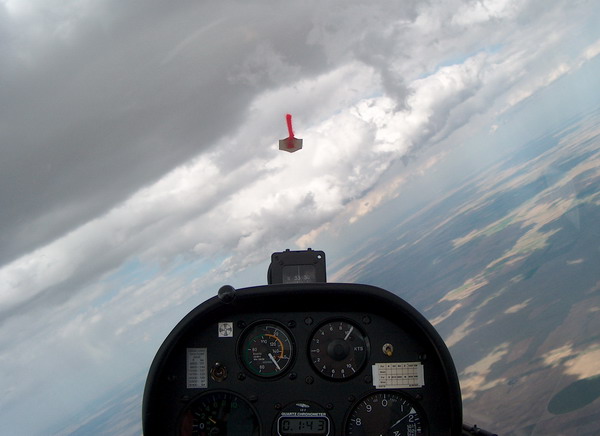 Soaring is the ultimate flying experience. It meets the needs of a diverse group of people, a sport that can be enjoyed at all levels: from relaxation on a quiet local flight, to experiencing the thrills of soaring across the countryside, to the excitement of aerobatics, to the regional and international racing competitions. Gliders soar using the same air currents that birds use to fly, but have also been designed with the kind of aerodynamic efficiency that enables top speeds of up to 120 mph. Distances of over 1,000 miles have been covered in one day, and heights of over 40,000 feet have been achieved.
Soaring is the ultimate flying experience. It meets the needs of a diverse group of people, a sport that can be enjoyed at all levels: from relaxation on a quiet local flight, to experiencing the thrills of soaring across the countryside, to the excitement of aerobatics, to the regional and international racing competitions. Gliders soar using the same air currents that birds use to fly, but have also been designed with the kind of aerodynamic efficiency that enables top speeds of up to 120 mph. Distances of over 1,000 miles have been covered in one day, and heights of over 40,000 feet have been achieved.
Soaring allows you the freedom to explore the world from a unique bird’s eye view while enjoying a safe and challenging sport.
Soaring is a sport for all ages - from those who solo on their 14th birthday through middle age and into older age groups. There is no upper age limit.
Sailplanes
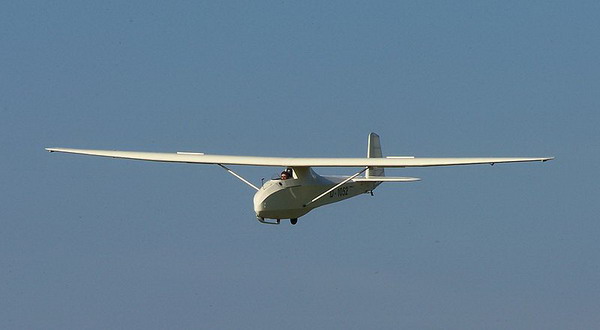 What folks refer to as a glider is actually a sailplane. Gliders are usually defined as a motorless airplane, and were used extensively in World War II to transport troops and equipment silently behind enemy lines. Gliders generally had poor performance as compared to today's sailplanes.
What folks refer to as a glider is actually a sailplane. Gliders are usually defined as a motorless airplane, and were used extensively in World War II to transport troops and equipment silently behind enemy lines. Gliders generally had poor performance as compared to today's sailplanes.
A sailplane is always descending, but use nature's lift sources to offset the sailplane's decent. Sailplanes can fly great distances with surprising speed.
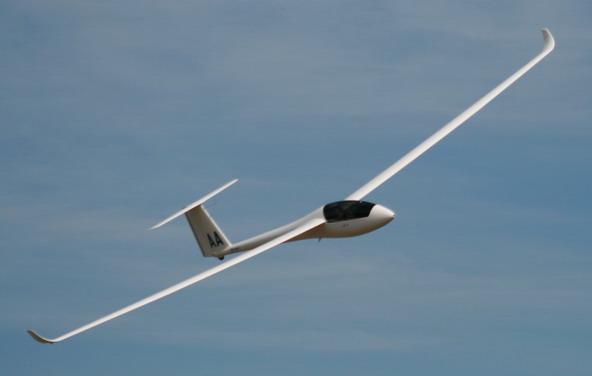 Sailplanes vary in terms of construction and size. They have evolved from crude gliders which were open box-kites large enough to carry a person to the enclosed fiberglass/carbon fiber sailplanes we fly today. In the early years of gliding, flights of 30 miles were hailed as a triumph. Today a 30 mile flight is considered more routine.
Sailplanes vary in terms of construction and size. They have evolved from crude gliders which were open box-kites large enough to carry a person to the enclosed fiberglass/carbon fiber sailplanes we fly today. In the early years of gliding, flights of 30 miles were hailed as a triumph. Today a 30 mile flight is considered more routine.
Sailplanes are controlled just like any other fixed-wing aircraft. The biggest difference is the lack of an engine which eliminates the complexities of controlling and managing it. Of course, this is replaced by the pilot always needing to think about where he/she will be able to land in the case where sources of lift run out. However, sailplanes are very efficient flying machines and can glide long distances. Glide ratios are measured by their L/D, or lift to drag ratio. An L/D of say 30/1 would mean a sailplane can glide 30 miles for a mile (~5000 ft) of altitude in calm air. Sailplanes you might see at OCGP range from having glide ratios of 23/1 for the trainer to 50/1 for the racing sailplanes. Following is a view of the major components of a sailplane. In this particular case, this is a 15 meter class (~50 foot wingspan) racing sailplane.
 |
|
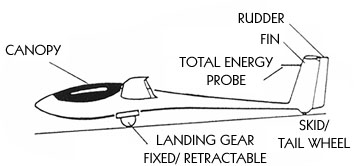 |
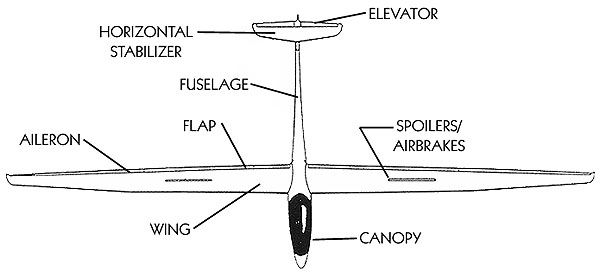 |
Learning to Fly
The instructor can teach you the mechanics of flying the aircraft in just a few lessons. But don't be led too quickly into thinking that you have learned all there is to know. Learning to soar is a series of steps and plateaus. How high on that ladder you wish to climb is up to you. Some pilots are content, at least for a while, to soar around an airport.
Others find exhilaration and satisfaction in cross-country flight and ultimately in competing with other pilots. Learning while flying is fun; a fine balance of determination, flexibility and much practice is necessary to gain the proficiency and skills you will need to get the most out of your sailplane and your rating.
The sport requires alertness, self-control and self-discipline. It requires a combination of coordination, flexibility of thought, quick decision-making, and good judegment - all skills which can be achieved only through conscientious effort. The requirements for continually taking off and landing safely at the same airport are obviously not the same as those placed on a pilot who ventures into the unknown on a cross-country flight.
Student Pilot
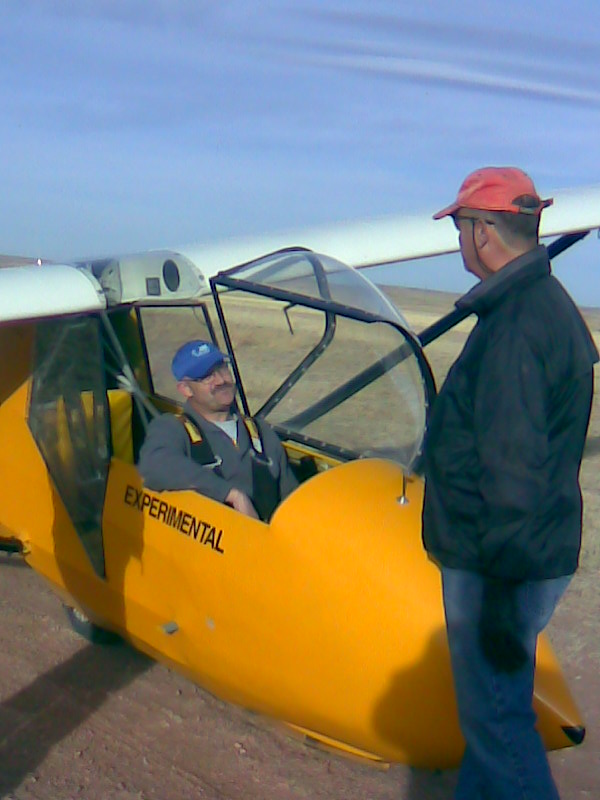 You fly with an instructor in a 2-seater, dual-control glider; you're in the front seat, the instructor is in the back seat, and you each have a set of controls. Flying a sailplane (or other aircraft) straight with wings level is fairly easy. Turning, flying on tow behind the tow plane, takeoffs and landings are more difficult. Teenagers tend to learn very quickly (you may solo a glider at age 14, and get a glider pilot’s license at age 16); adults tend learn somewhat slower.
You fly with an instructor in a 2-seater, dual-control glider; you're in the front seat, the instructor is in the back seat, and you each have a set of controls. Flying a sailplane (or other aircraft) straight with wings level is fairly easy. Turning, flying on tow behind the tow plane, takeoffs and landings are more difficult. Teenagers tend to learn very quickly (you may solo a glider at age 14, and get a glider pilot’s license at age 16); adults tend learn somewhat slower.
Training flights are typically 15-45 minutes. First you start learning stick and rudder skills. You practice with an instructor until ready to solo.
How long it takes to reach a level of proficiency to solo depends on a number of factors. They might include any previous pilot experience, how open you are to your instructor's guidance, and how relaxed you are. Other factors would include the type of sailplane you are flying, weather during flight training, and how consistent your flight training proceeds.
Fortunately, most human beings have the inherent capability of becoming fine glider pilots. The more you learn, the more fun and personal satisfaction you will have. The rapid growth of the glider movement is testimony to the rewards and satisfaction other glider pilots have found in their chosen sport.
The closer together the lessons are, the easier it is to build on the knowledge gained from the previous lessons, and the faster you will learn. Most people try to fly at least once a week, and most prefer to take more than one flight during each lesson.
The sailplane you will fly has dual controls, and your instructor will sit behind you with all the directional controls that you have and will show you the control motions or follow along with you as you are learning.
If you have not flown before, some of the maneuvers and coordination may seem difficult at first, just as riding a bicycle may have seemed nearly impossible when you were first learning.
After a few flights, however, you will be making the sailplane do what you want it to do, and you will wonder why you felt so clumsy on your initial flights. Basically you learn to fly your sailplane straight-and-level, to turn in varying degrees of bank while controlling your airspeed, and to recognize and recover from stalls. You will practice flight courtesy and safety.
You will learn how to enter the airport traffic pattern. You will fly your traffic pattern and approach precisely, land your sailplane with its wings level, and stop where you want to stop. Some common emergency procedures are also taught.
Sailplanes are docile and responsive and answer to gentle, control input. As your "touch" develops, you will become less and less conscience of the control movements necessary to make the sailplane respond to your wishes.
Student Pilot - Solo
You can solo if you are 14 years old or older. Most instructors feel that 30 to 40 flights of pre-solo flight time are the minimum needed for most people with no previous flight experience. An experienced private power pilot can generally solo a sailplane in 15 flights. After you have soloed, you will continue to fly with an instructor from time to time to see that you are maintaining good flying habits and developing your judegment and flying skills.
After Solo
Once you are released/signed-off by your certified flight instructor, you may fly by yourself. You are not allowed by federal regulations to take passengers until you have you Private Pilot's License. While flying solo most student pilots finish studying for their pilot license flight exam and also learn more about "soaring" - staying aloft for longer periods of time.
FAA Private Pilot Glider License
You will be eligible for a private pilot glider flight exam if you; (1) are 16 years old or older, (2) have 30 flights (3) have the FAA minimum solo flight time in a sailplane, and (3) have passed the FAA written examination, and (4) have your instructor’s endorsement.
These regulations apply if you have had no previous FAA ratings. But if you already have a private or commercial power pilot rating with 40 hours of solo time, you can be licensed in gliders if you have a minimum of 10 solo flights during which 360 degree turns have been made, and have passed a flight test. No additional written FAA examination is required, although the oral test given by the flight examiner generally covers the same material which would be covered in the written examination.
After you obtain you private pilot license you are free to take passengers, and pursue your personal goals, be that learning to fly cross-country, instructing, badge or record flying, or just flying around the gliderport for fun! Your pilot's license is just the beginning; it's your license to learn!
FAA Flight Test For Your Private Pilot’s License
As with any course of study, the more material you read on your own, the faster you'll learn and the more competent you'll be. You will be studying this material while you are taking your flight lessons, and after you have passed your FAA written examination and your flight instructor has given you his or her blessing, you will take your private pilot test. Obtaining you Private Pilot’s License will entitle you to take passengers with you.
Frequently Asked Questions
How do we get up there?
In the early years, a winch or bungee cord was used to launch gliders off of the side or top of a hill. Today we still use winches but aero tows are more common in the US. A small power plane is used to tow the sailplane aloft using a 200' long polypropylene rope, about 3/8" thick. Once the two aircraft reach approximately 2,000 feet (the common height for aero tow release) the sailplane releases the rope and begins soaring.
How does a sailplane stay aloft?
Pilots look for rising air currents (lift). Most commonly, it's in the form of thermals, bubbles of hot air that rise from ground heated by the sun; on days with enough moisture in the atmosphere, the warm air will condense at altitude to form puffy white cotton-like summer clouds called cumulus.
Other sources of rising air are: ridge lift - wind blowing up a mountain slope, or wave-higher altitude vertical waves downwind from the wind blowing up the side of a mountain range.
What are "good soaring conditions?" What happens if the wind quits?
Wind is not the key ingredient -- what a soaring pilot needs is rising air (lift). If a pilot finds rising air, he does what he can to stay in it. On most days, air rises as a result of the sun heating the ground, and therefore the air at ground level. The heated air rises, until it is in air with the same density. So soaring pilots need sunny days, with unstable air capable of rising.
What happens if you don't find lift?
The sailplane decends in a gradual glide, like a paper airplane. Safe and prudent soaring pilots plan their flights and landings according to the current soaring/weather conditions.
What about the landing?
Landing an airplane is the same, whether you have an engine or not, but in soaring you only get one shot at it. This sounds more scary and harder than it is.
All pilots fly a pattern and approach. As the sailplane is already descending the pilot only has to modify (increase) the rate of decent using dive brakes or spoilers. The pilot will correct for drift due to cross-winds. When the pilot is near to the ground he will even off the decent rate and then touch down onto the runway. Momentum ensures that the plane rolls evenly on its main wheel. Only when the plane stops rolling does a wing gently touch the ground.
Updated 05/24/2014
Previous page: Welcome to the Colorado Soaring Association
Next page: Scenic Flights and FAST at Owl Canyon Gliderport
